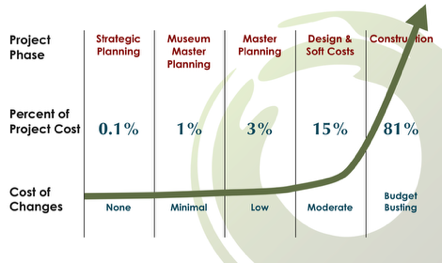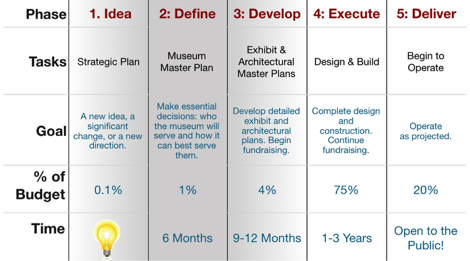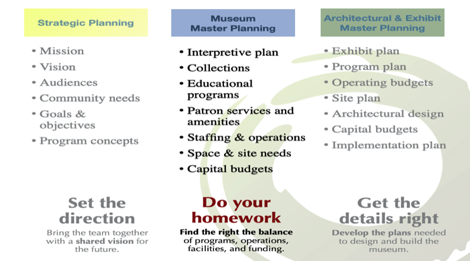Master Planning for Museums
How We Think About Museum Planning
At the heart of our museum mastep lanning process is our understanding that museums are best understood by who they serve, not by what they have or what they do.

Our work usually falls in between the strategic plan that outlines a museum's goals, and the architectural and exhibition plans that detail specifics. Our Museum Master Plans are a blueprint for how to turn those goals into reality.
A Museum Master Plan Asks "What Happens if...?"
Understanding the interests, needs, and desires of each museum’s many different consituent groups is the critical first step in museum planning.
Most museum planning projects seem simple at first: "We need more space,” or “We need to rethink our visitor experience,” or “We need to generate more earned revenue.” And the ideas come easily enough: add on a new wing, develop a new exhibit, or increase marketing.
But often the simple ideas simply don’t work.
The new wing will disrupt visitor circulation, research shows that visitors want a different experience than what we planned, or earned revenue proves to be elusive.
Rather than jumping to conclusions, we dig in and explore multiple alternatives until we find the simple, elegant solution that best meets community needs.
Sometimes, a Museum Master Plan is the first step in planning a new building or a major expansion. Just as often, it results in a new programmatic direction, a new business model, or as the foundation for a fundrasing campaign.
Why Invest in a Museum Master Plan?

Planning is cheap. Executing is expensive.
Taking the time to develop a Museum Master Plan allows a museum to think through and test alternatives before expnsive commitments are made for a change in direction or for new design and construction.
Our Museum Planning Process
We ask and answer six main questions:
What are the museum’s mission and vision?
Collect? Preserve? Exhibit? Educate? Inspire? Provoke?
What are the museum’s resources and constraints?
Collections? Exhibits? Staff? Board? Site and building?
Endowment? Membership? Community support?
Government funding?
Who are the museum’s constituents?
Tourists? Local residents? Families? Seniors? Children?
Collectors? Scholars?
What kinds of programs will best meet the community's needs?
Collections? Long-term Exhibits? Temporary Exhibits? Classes? Lectures? Demonstrations? Publications? Online activities?
What kinds of facilities are needed to meet the programmatic needs?
How much space is needed? What kind of building would be best? Is the existing site adequate? If not, should the museum be re-located?
How does the money work?
Where does operating revenue come from? How many staff are needed? Is a capital campaign feasible? What are the operating expenses? How do we balance investments in exhibits, architecture, and endowment?
Where Does Museum Insights Fit?
The work of a major museum project typically takes place in five phases, beginning with the inital idea and ending with implementation. The second phase is the most crucial as it is when the major decisions about the project are made.

Museum Insights typically works in the first three phases of a major project, with the bulk of our work concentrated in the Definition phase.
